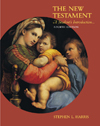 |
1 |  | 
The Gospel of Luke is often associated with what other New Testament book? |
|  | A) | The Gospel of Matthew |
|  | B) | The Gospel of Mark |
|  | C) | The Gospel of John |
|  | D) | The Book of Acts |
 |
 |
2 |  | 
The author of the Gospel of Luke addresses his work to a man named Paul of Tarsus. |
|  | A) | True |
|  | B) | False |
 |
 |
3 |  | 
Luke, the traditional author of the Gospel that bears his name, was a(n) _______________ by profession. |
|  | A) | physician |
|  | B) | politician |
|  | C) | carpenter |
|  | D) | fisherman |
 |
 |
4 |  | 
According to some traditions in the early church, the author of Luke was a traveling companion of the apostle _______________. |
|  | A) | Paul |
|  | B) | Peter |
|  | C) | John |
|  | D) | James |
 |
 |
5 |  | 
A long, central section of the Gospel of Luke, the "Greater Interpolation" of Luke 9:51-18:14, is a miscellaneous compilation of Jesus' teachings while he was on the road from Galilee to Jerusalem. |
|  | A) | True |
|  | B) | False |
 |
 |
6 |  | 
One of the main thematic interests of Luke is Jesus' and the disciples' use of prayer. |
|  | A) | True |
|  | B) | False |
 |
 |
7 |  | 
Luke shows Jesus' solidarity with the entire human race by tracing Jesus' genealogy back to the Old Testament figure of ________________. |
|  | A) | Adam |
|  | B) | Moses |
|  | C) | Abraham |
|  | D) | King David |
 |
 |
8 |  | 
Luke is the only Synoptic Gospel writer to refer to Jesus using the title of ______________. |
|  | A) | Messiah |
|  | B) | King |
|  | C) | Priest |
|  | D) | Savior |
 |
 |
9 |  | 
Luke 6 contains a briefer version of the Sermon on the Mount in Matthew called the Sermon on the Plain. |
|  | A) | True |
|  | B) | False |
 |
 |
10 |  | 
The Gospel of Luke is notable for the degree to which the author stresses the role of ______________ in the ministry of Jesus. |
|  | A) | women |
|  | B) | priests |
|  | C) | Pharisees |
|  | D) | Pontius Pilate |
 |
 |
11 |  | 
In the Gospel of Luke, Jesus does not stress the dangers of wealth or material possessions as strongly as he does in the other Gospels. |
|  | A) | True |
|  | B) | False |
 |
 |
12 |  | 
The parable of Lazarus and the rich man is about ________________________. |
|  | A) | a loving father who forgives his wayward son. |
|  | B) | a dramatic reversal of fortunes in the afterlife. |
|  | C) | a wedding party at which the wine runs out. |
|  | D) | a dishonest tax collector who begs God for mercy. |
 |
 |
13 |  | 
The three parables in Luke 15, dealing respectively with sheep, a coin, and two sons, are tied together by the theme of __________________. |
|  | A) | things that are beyond human understanding. |
|  | B) | things that are of inestimable value. |
|  | C) | things that can cause pride and jealousy. |
|  | D) | things that were lost and then found. |
 |
 |
14 |  | 
The Gospel of Luke modifies Mark's version of Jesus' End time discourse by emphasizing that the Parousia will come immediately after the destruction of Jerusalem. |
|  | A) | True |
|  | B) | False |
 |
 |
15 |  | 
More than any other Gospel writer, Luke emphasizes the innocence of Jesus and his followers of any crime against Rome. |
|  | A) | True |
|  | B) | False |
 |
 |
16 |  | 
When Jesus is brought to trial before Pilate, the Roman governor, Pilate realizes that Jesus is a Galilean, so he sends Jesus to be tried by _______________. |
|  | A) | Herod Antipas |
|  | B) | Caiaphas |
|  | C) | Tiberius |
|  | D) | Joseph of Arimathea |
 |
 |
17 |  | 
One of Jesus' last acts before dying on the cross in the Gospel of Luke is to ___________________. |
|  | A) | call for his mother. |
|  | B) | turn his blood into wine. |
|  | C) | ask God to forgive his executioners. |
|  | D) | declare his innocence. |
 |
 |
18 |  | 
According to the Gospel of Luke, when a centurion standing by sees the manner of Jesus' condemnation and execution, the centurion declares, "Beyond all doubt, this man was innocent." |
|  | A) | True |
|  | B) | False |
 |
 |
19 |  | 
Luke omits the tradition found in the Gospel of Mark that Jesus would appear in Jerusalem and sets all of the resurrection stories in Galilee. |
|  | A) | True |
|  | B) | False |
 |
 |
20 |  | 
Luke emphasizes the physical reality of Jesus' resurrection when he portrays the resurrected Christ as eating fish and capable of being touched. |
|  | A) | True |
|  | B) | False |
 |



 2002 McGraw-Hill Higher Education
2002 McGraw-Hill Higher Education